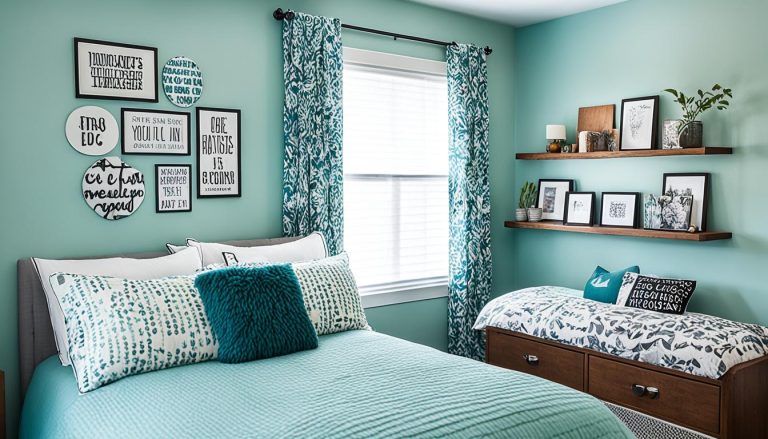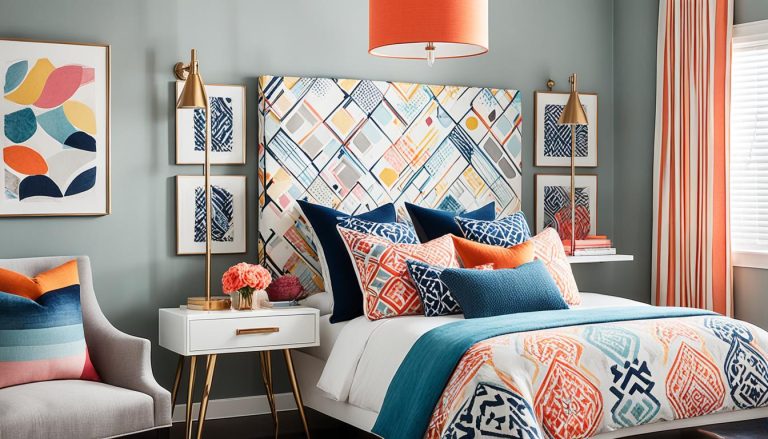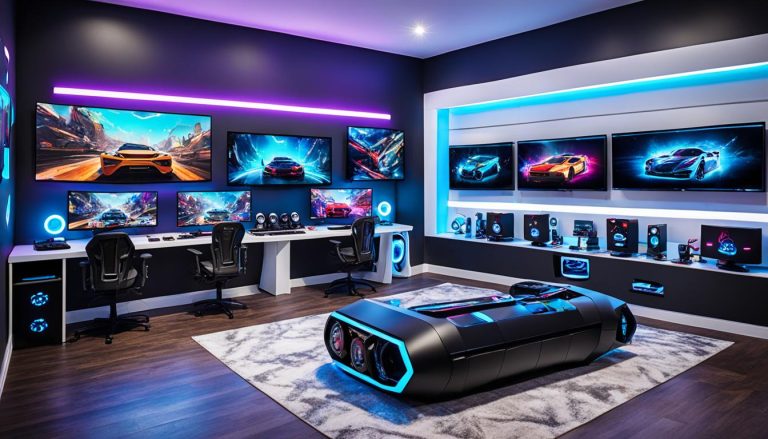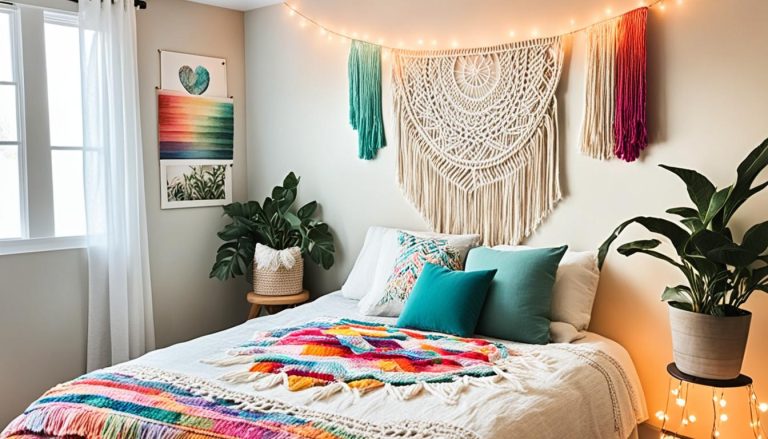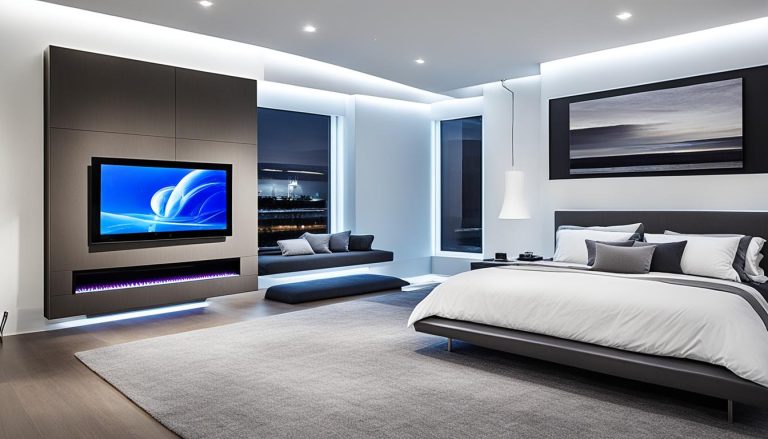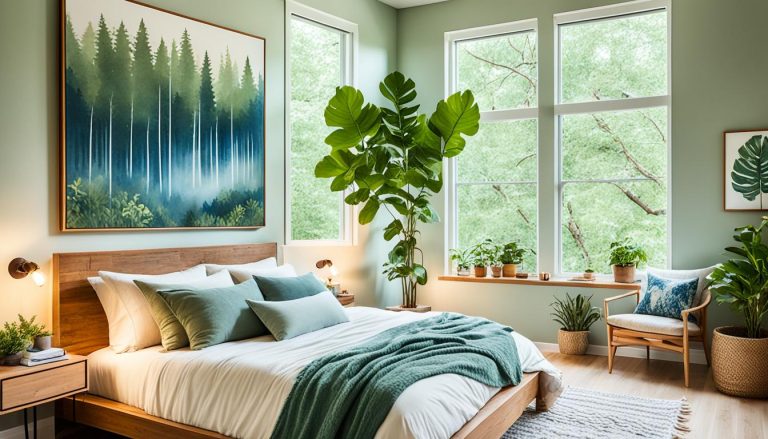Creating Study-Friendly Teen Bedrooms: A Guide to Productive Spaces
houseremodelingnews.com may earn a commission if you purchase a product through one of our links
Do you remember the chaos of your teenage bedroom? Clothes were everywhere, books stacked high, and you felt guilty for not studying. Now, as a parent, you’re faced with the task of helping your teen create a space that supports both rest and productivity. It’s not just about keeping things tidy; it’s about making a space where your child can excel in school and grow as a person.
Creating study-friendly teen bedrooms is more than a design project. It’s an investment in your child’s future. With the right approach, you can turn a cluttered room into a place that boosts focus and creativity. Let’s look at how to design the ideal study space that meets your child’s needs and reflects their style.
Did you know that the classroom environment can affect student learning by up to 25%? Think about the impact when you bring that to your home. By combining sleep and study areas thoughtfully, you’re doing more than cleaning up. You’re creating a space where your teen will be eager to study and aim high.
Understanding the Importance of a Study-Friendly Environment
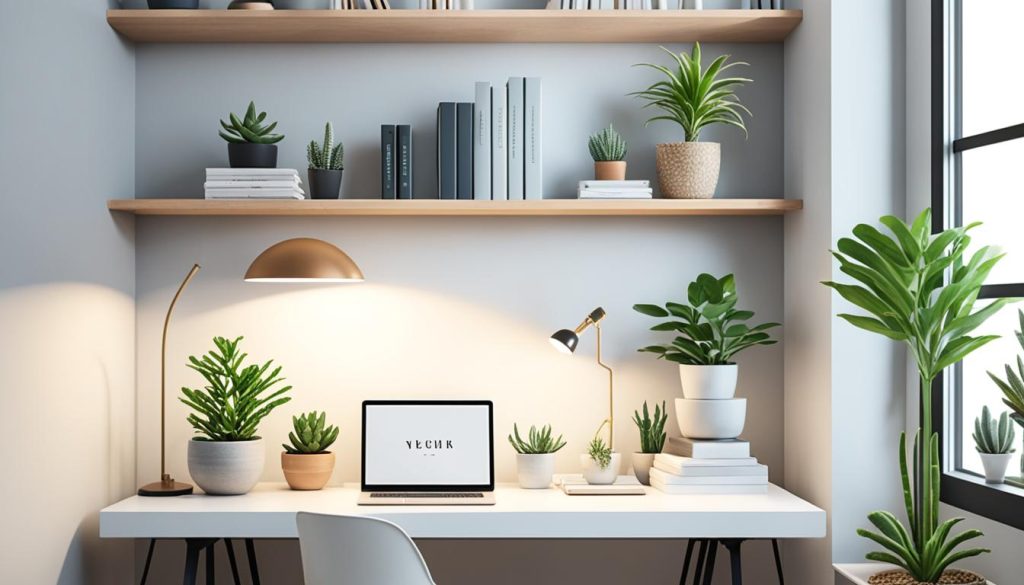
Creating a productive study space in your teen’s bedroom can greatly improve their academic success. A well-designed area boosts focus and productivity. It’s not just about having a desk and chair. It’s about making an environment that supports learning and growth.
Functional bedroom layouts are crucial. They help separate the study area from the rest of the room. This mental boundary makes it easier for your teen to switch between work and relaxation.
Here are some key factors to consider when setting up a study-friendly environment:
- Lighting: Good lighting reduces eye strain and keeps energy levels up.
- Comfort: An ergonomic chair supports good posture and helps maintain focus.
- Organization: A clutter-free space minimizes distractions and promotes efficiency.
- Personalization: Adding personal touches can make the study area more inviting.
Did you know that according to a 2014 report, three-quarters of Americans believe it’s crucial for libraries to offer safe study spaces for teens? This shows how important dedicated learning environments are for young people.
A well-designed study space is like a launch pad for success. It gives teens the tools they need to soar academically.
By investing time and thought into creating a productive study space, you’re setting your teen up for success. You’re also teaching them valuable skills in organization and time management.
Choosing the Right Desk Bed Combo
Desk bed combos are great for teens’ study areas. They combine sleep and study spaces, ideal for small rooms. Let’s look at some top picks that can turn your teen’s bedroom into a study spot.
High Sleeper Desk Beds
High sleeper desk beds have a workspace under the bed. The Twin XL High Loft Bed with Straight Ladder and Long Desk costs $1,619.00. It uses floor space well and gives a special study area.
Beds with Pull-Out Desks
For a smaller space, consider beds with pull-out desks. These designs tuck the desk away when not needed. The Small 2 Drawer Desk, priced at $489.00, pairs well with a bed for a neat look.
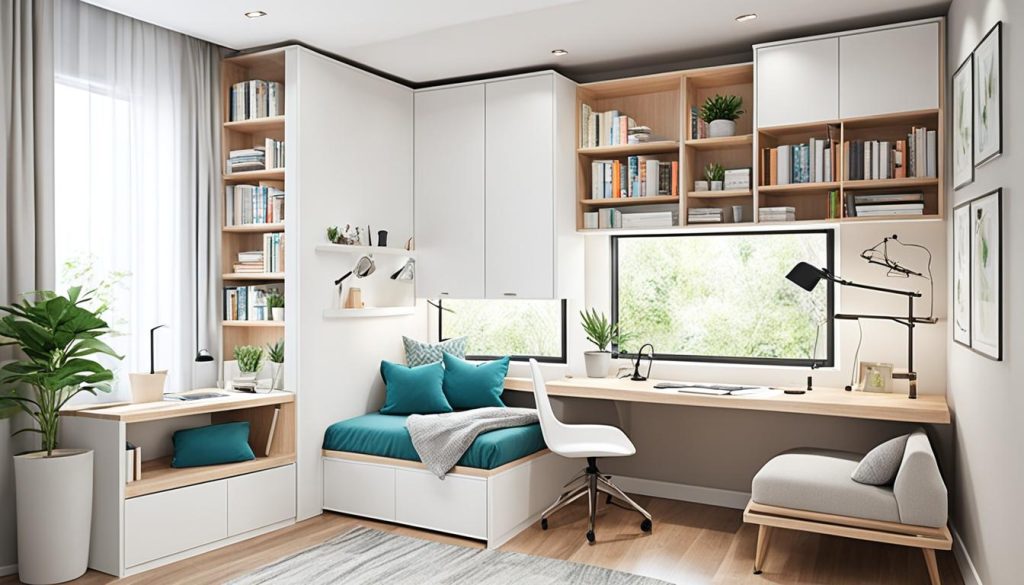
Beds with Desk and Sofa
Combining a bed, desk, and sofa makes a teen’s room versatile. The Twin High Corner Loft with Straight Ladder and Angled Ladder costs $2,129.00. It has a cozy spot for reading or relaxing and a study area.
Beds with Desk and Storage
Storage is key in teen bedrooms. The Full XL High Loft Bed with Straight Ladder and Long Desk is $1,499.00. Pair it with the 2 Drawer Underbed Dresser Unit ($489.00) for more storage. This combo makes a great study nook with lots of room for books and supplies.
The right desk bed combo can increase productivity by up to 25%, says a University of Salford study. Choosing the best multifunctional furniture sets your teen up for success.
Selecting Ergonomic Furniture for Comfort and Productivity
Choosing the right furniture is key for your teen’s comfort and focus. The right desk setup can greatly improve posture and concentration during study time.
When picking out ergonomic study desks, keep these important measurements in mind:
- Desk height: 60-72 cm (24-28 inches)
- Desktop surface: At least 80 by 160 cm (32 by 63 inches)
- Distance from eyes to screen: About 70 cm (28 inches)
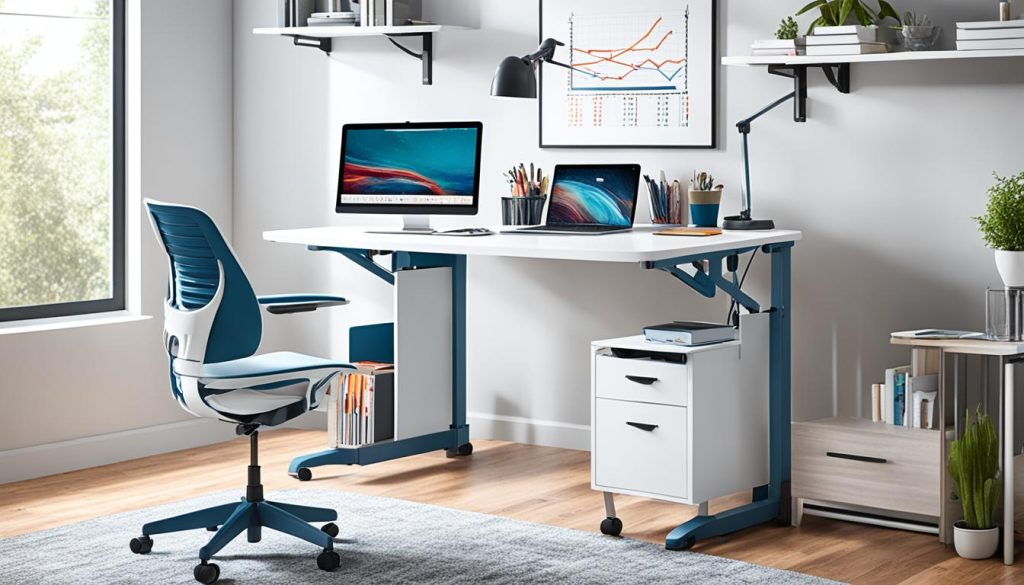
- Seat height: 40-55 cm (16-22 inches)
- Tilt range: 10 degrees back to 15 degrees forward
- Back support: Up to 30 degrees adjustment
- Armrest height: 23-26 cm (10 inches)
Good ergonomics can make your teen feel better and study more efficiently. A smart desk or an ergo chair designed for kids can support your teen through their school years.
It’s also a good idea to put the desk near a window for natural light. This setup can help with productivity and reduce eye strain. With the right furniture, you’re helping your teen succeed in their studies.
Optimizing Lighting for Better Focus
Good lighting is key for effective learning. The right lighting setup can boost focus and cut down on eye strain. Let’s look at some smart ways to light up your study area.
Natural Light Solutions
Natural light is best for focus. Put your desk near a window to get sunlight. This helps with concentration and makes you feel better overall. Use sheer curtains to control glare while keeping the light in.
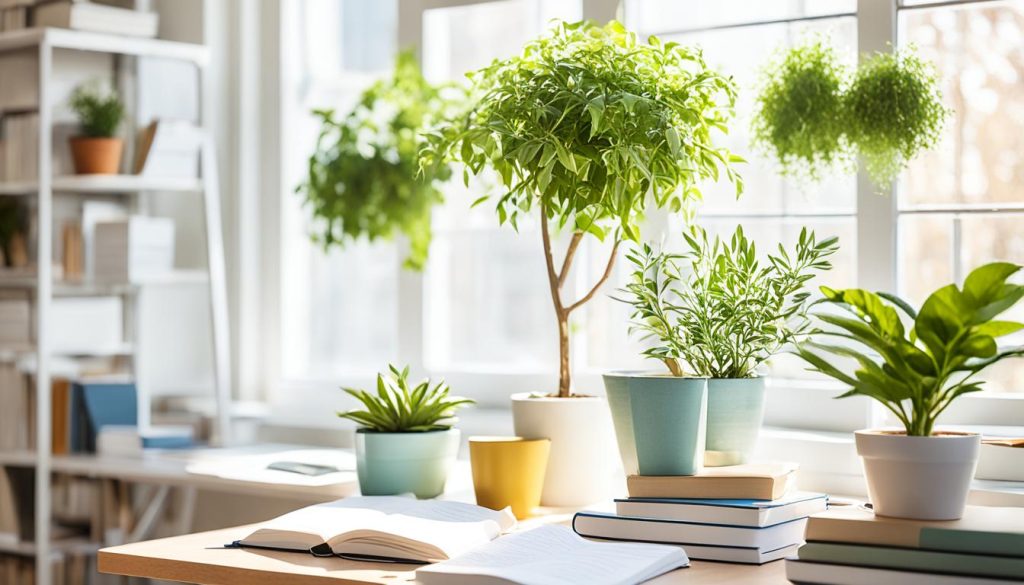
Task Lighting Options
Task lighting is crucial for focused work. A desk lamp with adjustable brightness is great for studying. LED desk lights are energy-saving and give clear light. Place the lamp so it lights up your work area without causing shadows or reflections on your screen.
Ambient Lighting Considerations
Finding the right balance with ambient lighting is important. Use warm, soft lights to make your space cozy. Think about getting dimmer switches to change light levels during the day. Smart bulbs let you switch between cool, energizing light for day and warm, relaxing light for night.
- Use cool white light (4100K – 5000K) during the day to enhance alertness
- Switch to warm yellow light in the evening for relaxation
- Add string lights or LED strips for a fun, personalized touch
The right lighting can change your study space, making you more productive and learning more fun. Try out different lighting setups to see what’s best for you.
Color Psychology in Study-Friendly Teen Bedrooms
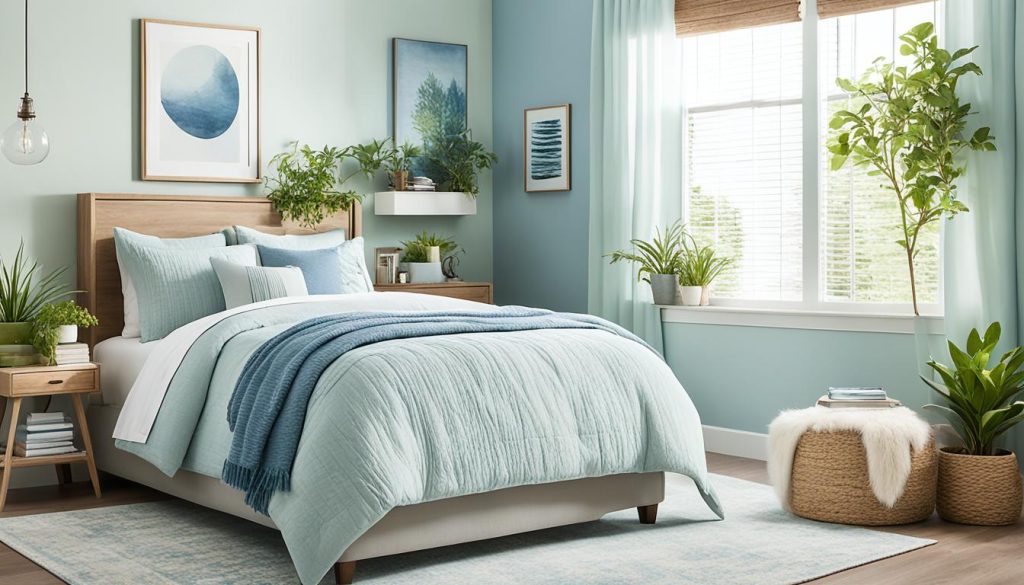
Choosing the right colors for your teen’s bedroom can greatly improve their study habits. Calming colors help make the space relaxing and conducive to learning. Studies show that colors can change mood, focus, and even grades.
Lighter colors are best for teen bedrooms. A study from the University of California found that kids do well with softer colors. Dark colors can make the mood drop, so it’s wise to avoid them. Here are some color ideas to think about:
- Light blue: Helps lower heart rate and blood pressure
- Soft green: Boosts concentration and promotes health
- Pale purple: Encourages relaxation and creativity
- Neutral tones: Create a calm, content feeling
When painting, choose shades that are a bit lighter than you think you want. Colors often look darker once they’re on the wall. This trick helps you get the perfect calming color scheme for your teen’s study space.
“Colors can inspire creativity, promote peace, and even influence academic success. Choose wisely to create the ideal environment for your teen.”
Remember, what your teen likes matters too. Talk with them about their favorite colors. By mixing their preferences with color psychology, you can make a bedroom that’s both stylish and great for studying.
Incorporating Plants for a Calming Atmosphere
Adding plants to your teen’s bedroom can make it a better place for learning. Plants make the room look nicer and clean the air, creating a calm space. A NASA study showed that common houseplants can clean up to 87% of air toxins in a day.

Choose easy-to-care-for plants like snake plants, aloe vera, or pothos for your teen’s room. These plants do well in different light and need little care. For teens with allergies or asthma, Boston ferns can clean the air and make it healthier.
Plants can also help with mental health. Studies say touching plants can calm you down, lowering stress and tiredness. This is great during study time or when facing exams.
- Spider plants: non-toxic to pets, easy to care for
- Peace lily: improves air quality, but toxic to pets
- Snake plant: low maintenance, but toxic to pets
- Boston fern: air-purifying and non-toxic to pets
If you worry about pets, choose safe plants like spider plants, Boston ferns, or areca palms. These plants are safe for pets but still add greenery to learning spaces.
“Nature-inspired decor can create a serene atmosphere conducive to learning and creativity.”
Even fake plants or nature-themed wall art can help with focus. Studies found that looking at greenery for just 40 seconds can really help you concentrate. So, plants are a great choice for any teen’s study area.
Minimizing Distractions in the Study Space
Creating a focused study environment is key to boosting productivity. Studies show that a well-designed study space can increase learner focus and achievement by 85%. Let’s explore ways to minimize distractions and create clutter-free rooms for optimal learning.
Managing Tech Devices
Tech devices can be major distractions. Keep phones and gaming consoles out of the study area. This simple step can reduce distractions by 40%, allowing teens to concentrate on their work.
Creating a Clutter-Free Zone
A tidy space promotes a clear mind. Organize study materials and keep only essential items on the desk. This practice can improve efficiency by 40%. Use custom storage solutions to maintain a neat, clutter-free room that enhances focus and productivity.
Noise Reduction Strategies
Noise can significantly impact concentration. Implement noise-canceling solutions to create a quiet study environment. Consider using:
- Noise-canceling headphones
- White noise machines
- Soundproofing materials for walls and windows
These strategies can help mask disruptive sounds and improve focus by up to 3%.
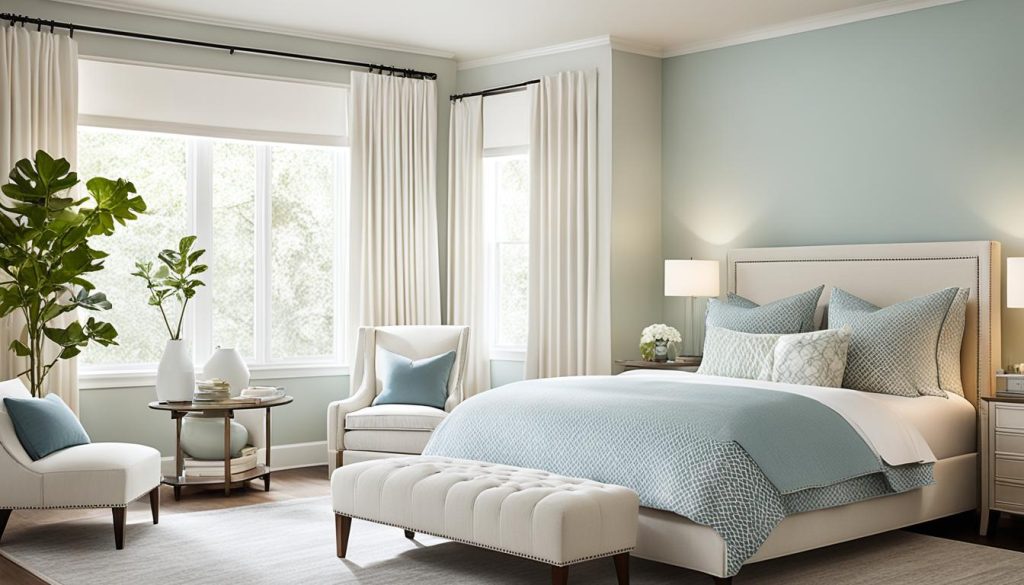
Remember, a distraction-free study space is crucial for academic success. By managing tech devices, creating clutter-free rooms, and implementing noise-canceling solutions, you can help your teen achieve their full potential. With these strategies, you’ll create an environment that boosts focus, creativity, and overall academic performance.
Organizational Solutions for a Tidy Study Area

Having a tidy study area is crucial for learning well. Smart organization helps focus and boosts productivity. Let’s look at some ways to keep your teen’s study area neat and welcoming.
Bookshelves are essential for any study area. They hold textbooks, notebooks, and more. Desks with built-in drawers save space and offer extra storage. Filing cabinets keep important papers organized and within reach.
Clear bins or drawers are perfect for small items like pens and pencils. They let you find things fast. Vertical storage like hooks and shelving units makes the most of small spaces.
- Use wire baskets for loose papers
- Install hooks for backpacks and jackets
- Set up desktop organizers for office supplies
- Hang a calendar to track important dates
The Holding Box method is a great hack. It uses a box for items without a home. This stops clutter from spreading on desks and shelves.
Encourage your teen to tidy up daily. A few minutes each day keeps big messes away. Remember, a clean space means a clear mind!
A place for everything and everything in its place.
With these storage ideas and hacks, you’ll make a study area that supports learning and success. A tidy room means a tidy mind, helping with academic success.
Personalizing the Space While Maintaining Functionality
Your teen’s bedroom is their sanctuary. It’s where they spend most of their time. So, it’s important to make it reflect their personality and stay functional. A well-designed teen room can boost motivation and make them feel like it’s their own.
Start with a good base for your teen’s room. Look at the size and pick furniture that fits well. Solid wood furniture can last a long time and grow with your teen. Modular storage units are great for changing needs.
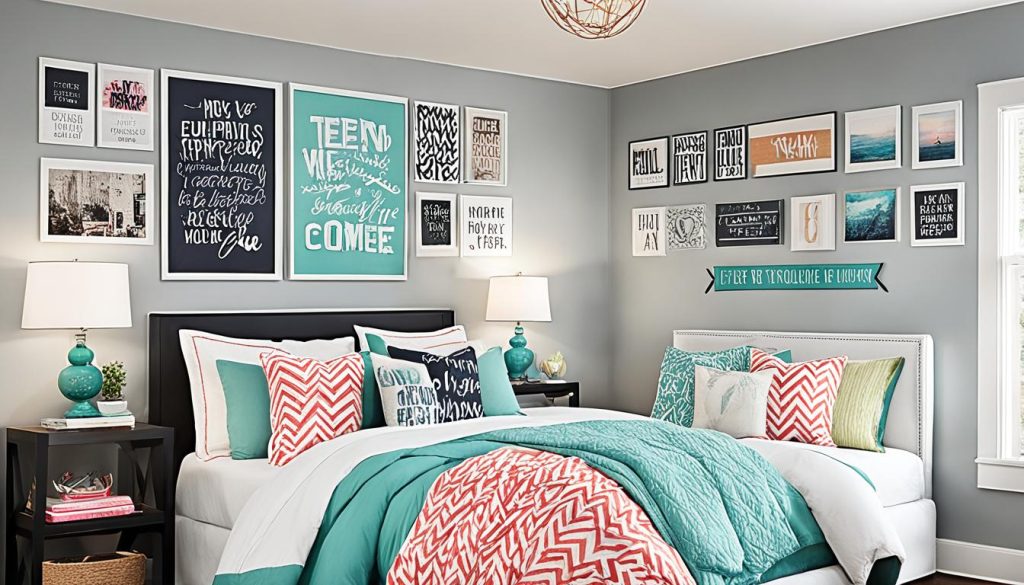
Color is key in teen room design. Blue and green help with calmness and focus, making them great choices. Let your teen pick accent colors that mean something to them.
Inspirational wall decor can turn a simple room into a place that motivates. Create a statement wall with:
- A photo collage of friends and family
- Motivational quotes or artwork
- Botanical prints for a nature theme
- Vintage posters for a retro look
Encourage your teen to do DIY projects for a unique touch. They could make their own wall art or a collage of dream destinations. These personal touches make the room truly theirs while keeping it good for studying and relaxing.
“A teen’s room should be a reflection of who they are and who they aspire to be.”
Remember, finding a balance is important. Personalize the space but keep it functional. Add smart storage and make sure there’s enough room for studying. With careful design and inspirational decor, you can make a space that’s both personal and practical.
Integrating Motivational Elements and Wall Art
Make your teen’s bedroom a place of inspiration with motivational decor and wall art. These can lift their mood, help them stay productive, and show off their unique style. Let’s look at how to make a space that boosts creativity and helps with school success.
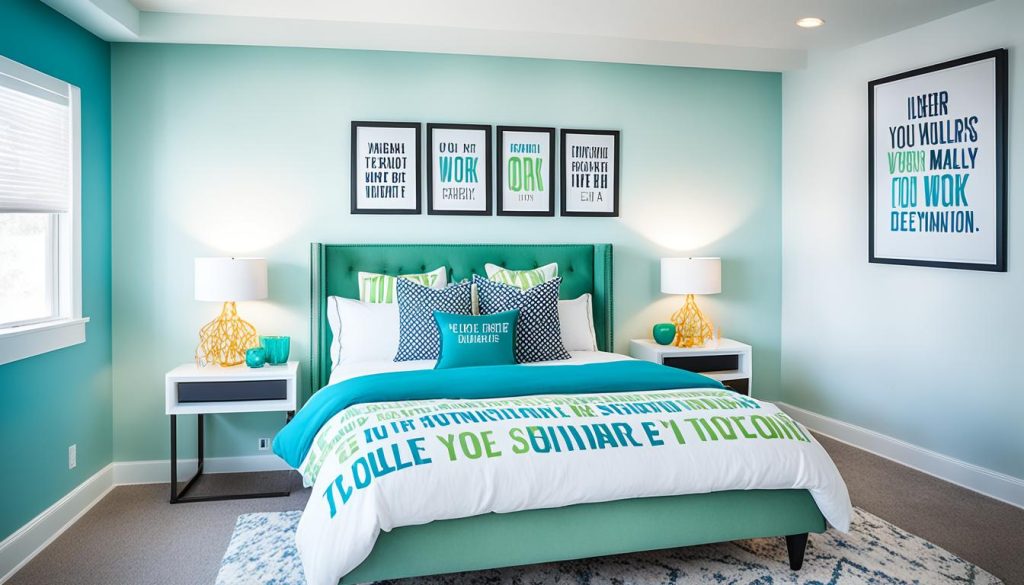
Begin by setting up an “achievement showcase” for your teen’s awards. Seeing their past wins can motivate them for the future. Pick a spot to hang medals, certificates, and photos of their best moments. Add floating shelves for trophies or special projects.
Use wall art that speaks to your teen’s goals and hobbies. Pick quotes that inspire but don’t get in the way. Think about using removable decals or framed prints for easy changes as they grow. Some ideas include:
- Inspirational quotes from role models
- Vision boards with future goals
- Colorful abstract art to stimulate creativity
- Educational posters related to subjects of interest
It’s important to keep things balanced when adding decor. Don’t overdo it with too many items. Instead, pick a few key pieces that fit well with the room’s look. The aim is to make a space that motivates and helps your teen grow.
“Your environment should inspire you to create, not just consume.”
By carefully adding motivational decor and wall art, you can make a study area for your teen that encourages focus, creativity, and growth. This positive space will help them do well in school and build their confidence.
Maximizing Space in Small Bedrooms
Got a tiny teen bedroom? No worries! With some clever tricks, you can turn that compact space into a stylish and functional haven. Let’s explore how to make the most of every inch in a small room.
Vertical Storage Solutions
Think up, not out! Vertical storage is your best friend in a small bedroom. Install floating shelves or tall bookcases to store books, trophies, and knick-knacks. Wall-mounted shelves painted the same color as the walls create a seamless look and add extra storage without cluttering the space.
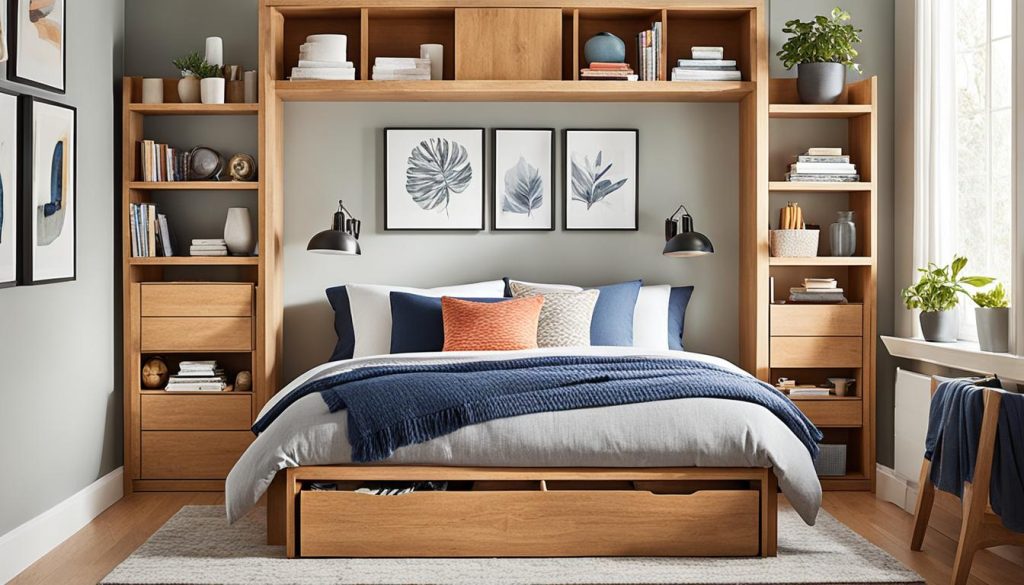
Multifunctional Furniture Ideas
Choose furniture that does double duty. A bed with built-in drawers provides sleeping space and storage. A desk with integrated shelves saves floor space while offering a spot for homework and display. For clothes, try a clothes rack with storage underneath instead of a bulky wardrobe.
Hidden Storage Tricks
Get sneaky with storage! Use under-bed boxes for sports equipment or out-of-season clothes. Opt for an ottoman with hidden storage for extra seating and a place to stash stuff. These efficient storage solutions keep the room tidy and support minimalist bedroom ideas.
Remember, even in a 7.7 square meter room, you can fit a bed, desk, and storage with smart planning. Mix new pieces from stores like IKEA with unique finds from second-hand shops to create a personalized space that’s both functional and cool.
Creating a Comfortable Seating Area for Reading
A cozy reading nook is key for any teen’s bedroom. It gives a break from the desk and helps with relaxing during study breaks. Think about comfort and usefulness when coming up with ideas for your nook.
First, pick the best spot. A window seat can bring in natural light and nice views. If that’s not possible, a corner of the room is also good. Choose a plush armchair or a small loveseat with soft cushions for the ultimate comfort.
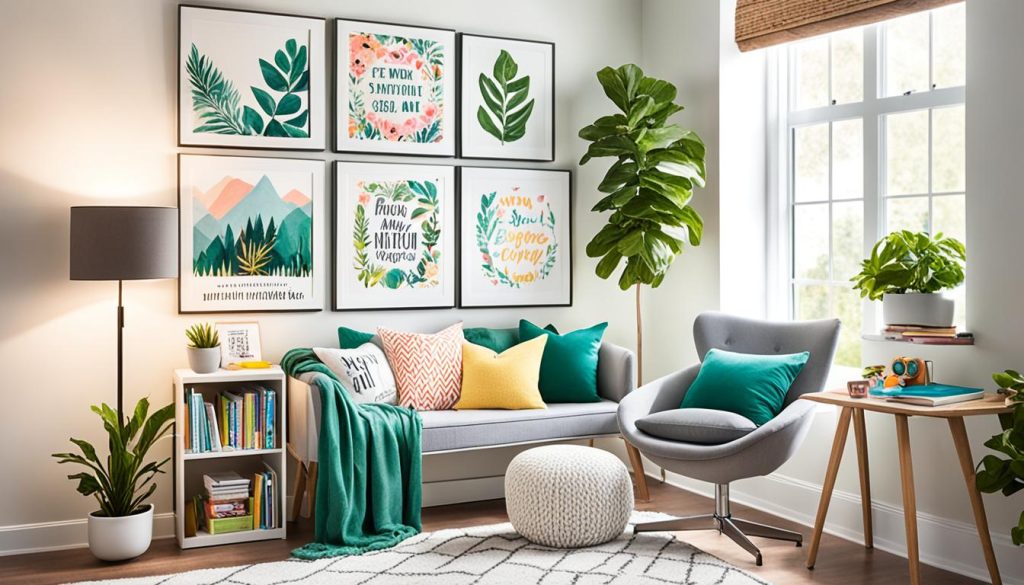
Lighting is important for a reading area. Put a warm lamp nearby for cozy evening reading. String lights can make your nook magical. Also, include storage for books and magazines with a small bookshelf or floating shelves.
Here are some ideas to make your reading nook special:
- Add a soft throw blanket and fluffy pillows
- Incorporate plants for a calming atmosphere
- Use a small side table for drinks and snacks
- Hang inspiring artwork or quotes on nearby walls
Your reading nook should show off your personality and be a comfy place to relax and focus on your books. With these ideas, you’ll have a perfect spot for both chilling out and learning.
Incorporating Technology for a Smart Study Space
Creating tech-friendly spaces in teen bedrooms is key for modern studying. A huge 80% of teenagers want technology in their rooms. This shows how the digital age makes smart gadgets a must-have in teen areas.

Begin by setting up a charging station for devices. This keeps everything charged and ready. Cable management solutions help keep things tidy. Adding a smart speaker like the Amazon Echo Pop, priced at $39.99, offers hands-free help during study time.
Lighting is important in tech-friendly spaces. The Adesso Emerson Desk Lamp, available for $122.62, has adjustable lighting for various study needs. For late-night studying, the TP-Link Kasa Smart Wi-Fi Power Strip HS300, priced at $49.99, lets you control devices from afar.
- Invest in a good laptop or tablet for digital learning
- Use noise-canceling headphones to minimize distractions
- Set up a small projector for group study sessions
Balance technology use with strategies to avoid distractions. Limit non-study tech use during study times. This keeps your tech-friendly space a place for learning and growth.
Adapting the Room for Different Study Styles
Creating a productive study space means thinking about different learning styles. Your teen’s room should be flexible for various study needs. It should change for different subjects or tasks.
Start by picking versatile furniture. A desk with wheels lets your teen move it easily. Add a comfy chair for reading and a floor cushion for sprawling out with textbooks. This mix supports different ways of studying.
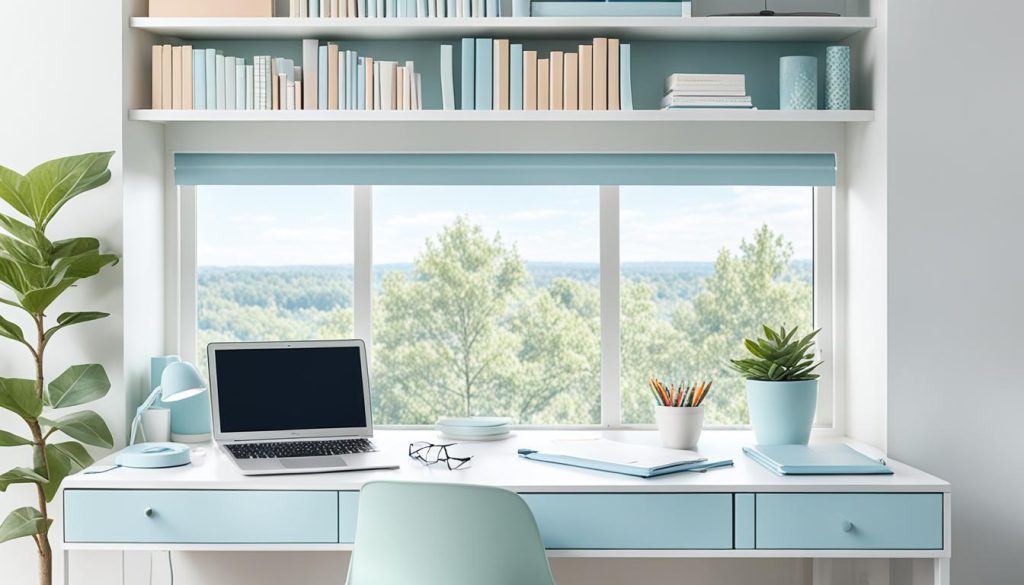
Color can set the right mood. Green helps with focus, while blue is calming. Use these colors in your teen’s study area to boost productivity. You might paint an accent wall or add colorful accessories.
Lighting is crucial for a productive study space. Natural light is best during the day. For evening study sessions, use a desk lamp to reduce eye strain. Consider a dimmer switch to adjust the lighting for the task at hand.
- Use floating shelves for easy-to-reach storage
- Try a pegboard for organizing supplies
- Add a small whiteboard for brainstorming
Remember, the goal is to create a space that adapts to your teen’s changing needs. With these tips, you’ll set up a productive study space that grows with your child’s learning style.
Final Thoughts: Empowering Teens with an Ideal Study Environment
Creating a great study space for teens is more than just a desk and chair. It’s about making a place that helps them grow, be independent, and do well in school. Since 86% of teens spend a lot of time in their rooms, it’s important to make it supportive.
It’s important to find a balance between being alone and being with others. 79% of teens look for this balance, and 72% of child psychologists say a personal space is key for emotional growth. By letting your teen help design the space, you’re making a study area that also lets them be themselves.
These study spaces can change over time. Adding things like a hopes and fears tree or a yoga corner can help with mental health. Music is also great for reducing stress and finding one’s identity. By carefully designing your teen’s study area, you’re giving them a strong base for both school and personal growth.

